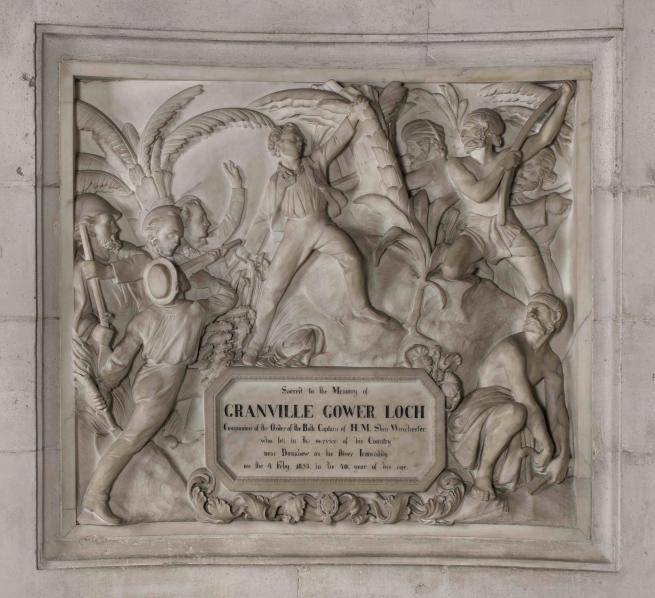Granville Gower Loch (1813-1853)

Image courtesy of Pantheons: Sculpture at St Paul's Cathedral.
Granville Gower Loch
1813-53
This work is part of The East India Company at St Paul’s: A digital trail produced in collaboration with Stepney Community Trust.
Written by M Ahmedullah, a community worker actively helping to equalise the powers of history by empowering traditionally disadvantaged people to engage in cutting-edge historical research, interpretation and dissemination. He has managed several heritage projects for Stepney Community Trust and Brick Lane Circle.
The following text is available in Bengali, Gujurati, Urdu, Hindi, Punjabi, and Tamil. Please email CollectionsDepartment@stpaulscathedral.org.uk to request a copy.

![]()
Granville Gower Loch is associated with two 19th century British imperialist wars of conquest in Asia – the First Opium War (1839-42) against the Chinese Empire and the Second Anglo-Burmese War (1852-3). Primarily engineered by British commercial interests, these wars ultimately forced two Asian powers to submit to British power, the former through a signed treaty based on British dictates, and the latter through the Burmese acceptance of the British Proclamation of Annexation of Pegu (Bago), Lower Burma.
The monument depicts Loch leading an all-white heroic expedition in the Burmese jungle, pushing against Burmese resistance and the obstructions of Nya Myat Toon's forces. Loch's expedition occurred soon after the British annexation of Lower Burma (Pegu) during the Second Anglo-Burmese War (1852-53). Nya Myat Toon was a Burmese resistance leader who fought against British advances from the beginning of the war.
The British used many negative terms to describe Nya Myat Toon. A contemporary British lieutenant in the Madras Artillery claimed that he was a 'robber chieftain’, ‘crafty chief', and 'dacoit' (a term used in South Asia to refer to bandits and robbers). At the same time, however, he also described him as one who 'had been deputed by the authorities in the Buddhistical celestial regions to drive the British "barbarians" into the sea, and prop up the falling Burmese Empire'. During his short jungle expedition, which began after he arrived in Rangoon and joined the war, Loch was shot and died two days later. He was buried in Rangoon.
In early March 1853, the British authorities mounted a large operation against Nya Myat Toon's resistance, which concluded with the seizing of Nya Myat Toon's stronghold near Rangoon (Yangon) and the dispersal of his forces. But the British failed to achieve their objective of capturing or killing Nya Myat Toon himself, and their losses from the expedition and a cholera outbreak numbered about 250 lives. Later, a third Anglo-Burmese War resulted in the British annexation of the rest of Burma in 1885, the destruction of the Burmese state, and the exile of its king, Thibaw Min, to a remote place in western India.
As a naval officer just over a decade earlier, Loch had fought in the First Opium War. The British were smuggling drugs into China mainly to fund their insatiable demand for Chinese tea. Seeing the impact of this trade in the form of cash drainage and addiction, the Chinese government attempted to bring it to a halt. The concluding parts of Britain's military response and victory were detailed by Loch in his journal, published in 1843. He witnessed the Chinese Emperor's representative signing the 'unequal' Treaty of Nanking with the British, which permanently gave Hong Kong Island to Britain and forced China to open five ports to foreign trade, in addition to paying compensation of $21 million for the cost of the war and the losses suffered by British traders. In his journal, Loch vividly describes China, its people and culture, including comments on Chinese women's foot-binding.
During the Second Opium War (1856-60), France joined Britain as an ally, and the two European powers marched together to Peking (Beijing), destroying and looting the imperial palace. The Russians took advantage of the Chinese predicament and forced them to cede 1.5 million square kilometres of its territory.
Although the British forces in these wars included native Indian soldiers (sepoys), and despite Loch playing a more prominent role in the First Opium War than the Second Anglo-Burmese War, there are no references to these aspects in the monument.
For detailed information about this monument, visit the Pantheons: Sculpture at St Paul's Cathedral website.

The East India Company at St Paul's
Explore the full digital trail produced in collaboration with Stepney Community Trust.




